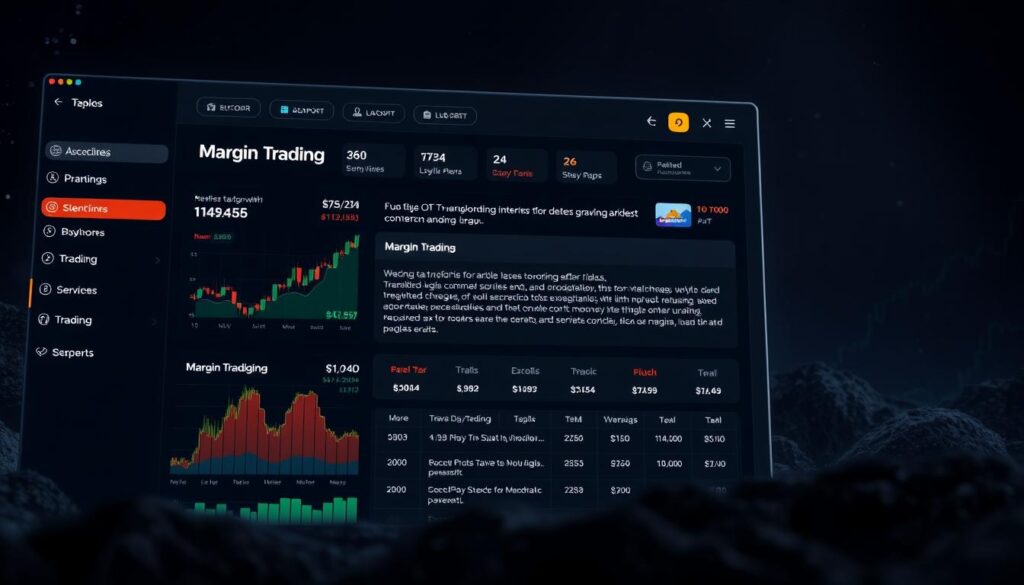Now Reading: Margin Trading Crypto? Watch Out for These Tax Consequences
- 01
Margin Trading Crypto? Watch Out for These Tax Consequences
Margin Trading Crypto? Watch Out for These Tax Consequences

Margin trading crypto can lead to big gains but also comes with hidden tax risks. The Crypto tax implications of margin trading mean you must track borrowed funds, interest, and forced sales carefully. Unlike regular trading, leveraged positions trigger taxable events at every step, from opening a trade to closing a loan.
Cryptocurrency tax rules view borrowed assets as taxable property, needing detailed records of all transactions. Interest paid on margin loans might be deductible, but missing a single entry could attract IRS attention. This guide helps you avoid penalties by following IRS guidelines.
Key Takeaways
- Margined trades generate taxable events at each transaction stage.
- Interest paid on crypto loans may reduce taxable income under IRS rules.
- Forced liquidations count as taxable sales under U.S. tax law.
- All borrowed crypto assets must be reported per IRS guidelines.
- Accurate records prevent audits and ensure proper deductions.
Understanding Crypto Margin Trading Fundamentals
Margin trading lets traders borrow funds from exchanges to boost their crypto positions. This practice amplifies potential profits but introduces higher risks. Traders must post collateral like Bitcoin or stablecoins, with borrowed amounts determined by exchange rules. Collateral serves as security, and failure to meet maintenance requirements can trigger automatic liquidations. These mechanics directly tie to margin trading taxation and crypto IRS regulations when calculating taxable events.
What Is Margin Trading in Cryptocurrency?
Margin trading involves borrowing assets to increase trade size. For example, a $1,000 BTC deposit with 3x leverage creates a $3,000 position. Exchanges set collateral ratios—often 50% to 150%—to ensure trader accountability. All gains or losses from these amplified trades become part of taxable activity under IRS guidelines.
How Leverage Works in Crypto Markets
Leverage ratios determine borrowing limits. Common levels include:
- 2x: $200 position with $100 deposit
- 10x: $1,000 position with $100 deposit
Risks grow with higher leverage. A 10% price drop on a 10x trade leads to a 100% loss of the initial deposit. Such losses may qualify for tax deductions under crypto IRS regulations, but documentation must align with IRS rules.
Key Differences Between Spot and Margin Trading
Spot trading involves immediate asset transfers, while margin uses borrowed funds. Key contrasts:
| Risk | Margin has amplified risk |
|---|---|
| Fees | Margin includes interest charges |
| Tax Treatment | Margin profits/losses are tracked separately for margin trading taxation filings |
These distinctions affect how transactions are reported on IRS forms like Form 8949, covered in later sections.
The Crypto Tax Implications of Margin Trading
Margin trading crypto means borrowing money to make bigger trades. But, this approach has its own crypto tax implications of margin trading. Unlike spot trading, using borrowed assets and paying interest brings new tax rules. Traders must keep track of every deal to report margin trading tax liabilities correctly and avoid IRS fines.
- Opening margin positions: No immediate tax event occurs
- Closing trades: Profits/losses become taxable upon settlement
- Interest expenses: Not deductible under current IRS guidelines
- Liquidations: Forced sales generate taxable gains even during losses
The IRS views crypto as property, so margin trades follow capital gains tax rules. Short-term gains (held under a year) face higher rates than long-term holdings. All transactions must be recorded on IRS Form 8949, regardless of borrowed funds used.
Current regulations have gaps in areas like decentralized exchanges and cross-border trades. Traders must document every transaction detail to comply with evolving rules. Getting professional tax advice is key in uncertain areas to handle these liabilities well.
How the IRS Classifies Cryptocurrency Transactions
The IRS sees cryptocurrency as property, as stated in Notice 2014-21. This rule affects how gains or losses are reported under cryptocurrency tax rules. It’s key for margin traders to know this to avoid penalties.
Property vs. Currency Classification
Every crypto transaction is taxable because the IRS views it as property, not currency. Important points include:
- Each trade results in a capital gain/loss based on cost basis.
- No foreign currency exceptions apply—every exchange counts as a sale.
Trading vs. Investment Activities
Margin traders need to tell apart trading (frequent, business-like activity) from investment (long-term holding). The IRS looks at factors like how often you trade, your experience, and your profit motive. Getting it wrong could mean paying more taxes under IRS guidelines for crypto margin trading.
Impact of Holding Periods on Tax Rates
Holding periods affect tax rates: cryptocurrency tax rules set a 0%, 15%, or 20% rate for long-term gains (over a year). Short-term gains (under a year) face income tax rates up to 37%. Margin traders often face short-term rates because of frequent trades.
Taxable Events in Margin Trading Crypto
Every action in margin trading can lead to tax triggers under crypto IRS regulations. Here’s how to spot events that lead to margin trading tax liabilities:
- Opening leveraged positions: Borrowing funds to buy crypto is a taxable event. The IRS sees borrowed crypto as “constructively received,” needing immediate tracking.
- Closing trades: Profits or losses from closing positions must be reported. Losses can offset capital gains, but only if documented correctly.
- Interest and fees: Interest on borrowed funds isn’t deductible. Fees like borrowing rates or liquidation penalties also impact net gains, changing taxable amounts.
- Forced liquidations: Even involuntary liquidations are taxable events. The IRS requires reporting gains or losses from forced sales, even if you didn’t start the trade.
- Receiving dividends or airdrops: Any rewards tied to collateralized assets during margin trades are taxable at fair market value when received.

Complex scenarios like cross-collateralization make asset ownership timelines unclear, complicating cost basis calculations. For example, using Bitcoin as collateral for an Ethereum trade might trigger separate taxable events for each asset involved. Under crypto IRS regulations, traders must track:
- Date and time of each transaction
- Fiat and crypto values at trade execution
- Interest accrued on borrowed funds
Missing these details risks misreporting gains or losses. The IRS expects records for every position opened, closed, or adjusted via margin. Proper documentation prevents audits and ensures compliance with evolving crypto tax laws.
Interest Payments and Their Tax Treatment
Managing interest costs on margin loans is key to tax planning. Keeping track and reporting these costs is crucial. It helps you follow the rules and save money by using deductions.
Deductibility of Margin Interest
Interest on margin loans for crypto trades might be deductible. But, there are important limits. The IRS lets you deduct only up to your net investment income. This includes your crypto gains.
- Interest from winning trades lowers your taxable income.
- Deductions stop when your investment income is gone.
- How you classify crypto affects your interest deductions.
Documentation Requirements for Interest Deductions
Proving interest expenses is vital to avoid IRS trouble. You need to:
- Keep statements from exchanges showing interest and dates.
- Connect interest to trades in your transaction logs.
- Record foreign exchange deals with currency conversions.
Without the right documents, you might lose your deductions. Use crypto tax software to keep your records in order. Make sure your data meets IRS standards before you file.
Calculating Cost Basis for Margin Trades
Tracking the cost basis accurately is key under cryptocurrency tax rules. Margin trading adds complexity due to borrowed funds and market changes. You must document every dollar and token, including interest, fees, and borrowed assets.
- Accounting Methods Matter: Pick FIFO, LIFO, or specific identification and use it for all transactions. The IRS wants you to be consistent.
- Incorporate All Costs: Add interest paid, trading fees, and platform fees to your basis. These costs lower your taxable gains.
- Track Partial Positions: When you close part of a leveraged position, split the basis based on what you sold.
Cross-platform trades or accounts need separate records for each exchange. Use trading logs or tax software to track every transaction. Not doing so can lead to audits. Regularly check your calculations to stay in line with changing tax rules.
Liquidations and Forced Selling: Tax Considerations
When margin positions get liquidated, taxes come into play. Every forced sale is a taxable event, even if you didn’t choose to close the position. It’s important to track these events to avoid margin trading tax liabilities.
Recognizing Losses from Liquidation Events
Liquidations are considered taxable dispositions. To calculate losses, use the cost basis of the crypto sold. For instance, if $5,000 in Bitcoin was liquidated at $3,000, you have a $2,000 loss. This loss can reduce your taxable income.
Keep records of trade dates, prices, and fees. Even if exchanges don’t report on Form 1099, you still need to document everything. IRS guidelines require documenting all transactions, including forced sales.
Tax-Loss Harvesting Opportunities
- Use liquidation losses to offset up to $3,000 in taxable income annually
- Apply excess losses to reduce capital gains tax on margin trading from other crypto profits
- Track losses via software to maximize deductions
Wash Sale Rule Considerations
The IRS hasn’t explicitly extended wash sale rules to crypto, but caution is advised. Avoid repurchasing identical assets within 30 days of a liquidation to prevent audit risks. For example, selling Ethereum due to a liquidation then buying it back too soon could jeopardize loss deductions.
Monitor IRS updates on this evolving area.
Record-Keeping Requirements for Crypto Margin Traders
Keeping accurate records is key for tax reporting for margin trading. The IRS guidelines for crypto margin trading ask traders to keep track of every deal, loan, and change in their positions. Without good records, audits could lead to fines or wrong tax reports.

- Trade confirmations for all buys/sells and leveraged positions
- Margin loan agreements and interest payment receipts
- Liquidation notices with execution prices and dates
- Cross-exchange activity logs showing collateral transfers
Tools like CoinTracking or Koinly can help track trades. But, you also need to keep manual records of:
- Leverage ratios at trade start
- Collateral asset values
- Platform-specific fees
These details help figure out the cost basis and prove the deal’s legitimacy during audits.
IRS audits can look back 3-7 years. If your records are not complete, you might lose deductions or face penalties. You need to keep proof of:
- Margin call notifications
- Loan repayment schedules
- Platform account statements
The IRS says traders are fully responsible for keeping evidence of their trades. Every trade’s entry/exit prices, fees, and interest must be clear. Not having this information can lead to IRS changes that are not in your favor.
Form 8949 and Schedule D: Reporting Margin Trading Profits and Losses
When it comes to tax reporting for margin trading, you need to use IRS forms like Form 8949 and Schedule D carefully. Cryptocurrency tax rules say you must list every margin trade, including when you liquidate or pay interest. Even if places like Binance or Kraken don’t show all the details, you still need to report it. If you don’t, you might face audits.
Every transaction must follow IRS rules to avoid penalties. Keeping accurate records is key.
Line-by-Line Guidance for Form 8949
To fill out Form 8949, follow these steps:
- Record each trade with the exact dates, cost basis, and proceeds. Short-term gains need their own entries.
- Mark down liquidation events as taxable disposals. You can use losses from forced sales to offset gains if you document them right.
- Move the totals to Schedule D, making sure to separate short-term and long-term columns.
For detailed examples, check out CoinLedger’s guide on filling out crypto-specific forms.
Common Reporting Mistakes to Avoid
Here are some common mistakes to steer clear of:
- Ignoring unreported trades: Even if a platform doesn’t send a 1099, you must list all disposals on Form 8949.
- Confusing short-term vs. long-term: Getting this wrong can mess up your capital gains rates.
- Missing liquidation entries: Forced sales during margin calls are taxable and need to be fully reported.
Not tracking margin interest or reconciling exchanges can lead to audits. Using crypto tax software can help automate calculations and cut down on mistakes.
Tax Software and Tools for Margin Trading Documentation
Handling crypto tax implications of margin trading requires good tools. Tax software makes tax reporting for margin trading easier by doing math and sorting out trades. Tools like CoinTracker, CryptoTrader.Tax, and Koinly help with margin trading, but they have some limits.
- CoinTracker tracks margin interest, liquidations, and cross-collateralization, supporting IRS compliance.
- CryptoTrader.Tax provides detailed reports for taxable margin events, aligning with Form 8949 requirements.
- Koinly integrates with major exchanges but may require manual adjustments for complex margin trades.
Exchange APIs often don’t have all the margin data, so traders have to enter it manually. Always double-check the numbers. Mistakes can happen because of missing data or special rules.
Choosing the right tool depends on how often you trade and which exchanges you use. If you trade a lot, you need a powerful tool. But if you only trade sometimes, a simpler tool might be better. Make sure your tool can export data for Form 8949 to make filing easier.
Cross-Border Implications for US Traders Using Foreign Exchanges
US traders using foreign exchanges for margin trading face unique crypto IRS regulations. They must pay close attention to these rules. Trading across borders means they must follow laws like FBAR and FATCA. Not following these rules can lead to big penalties, like audits or fines.
FBAR Requirements
- Report foreign crypto accounts if total value exceeds $10,000 during any calendar day
- File FinCEN Form 114 annually if accounts are held with foreign exchanges
FATCA Considerations
- Report certain foreign financial assets on Form 8938 if crypto margin balances meet IRS thresholds
- Failure to disclose can lead to 50% tax penalties on unreported amounts
Tax Treaty Implications
- Review treaties with exchange jurisdictions to avoid double taxation
- Losses may not transfer between countries under some agreements
Exchanges outside the US often lack tax documents like Form 1099. This makes following the rules harder. The IRS is now focusing more on cross-border crypto activity. They share information with foreign regulators more often.
Not following these rules can lead to serious consequences. This includes criminal charges for willful violations. It’s wise to talk to tax experts who know about international crypto IRS regulations. They can help you deal with the complex margin trading taxation issues.
Working With Tax Professionals: When to Seek Expert Help
Understanding cryptocurrency tax rules and margin trading tax liabilities can be tricky. If you trade a lot, often liquidate assets, or deal with complex items like derivatives, get a tax pro. They can help you avoid mistakes that might lead to audits.

- Annual crypto trades exceeding 50+ transactions
- Margin losses exceeding $10,000 requiring precise cost basis tracking
- Foreign exchange accounts with FATCA implications
- IRS disputes over asset classification
Look for advisors who know IRS Notice 2014-21 and blockchain audits well. Ask them:
- Do you handle margin trading tax liabilities for clients?
- Have you filed Form 8918 for constructive sales?
Be ready to show:
- Margin loan interest statements
- Platform transaction exports
- Loss calculation spreadsheets
CPAs focus on following the rules, while tax attorneys defend you in audits. Rates start at $250 an hour. But, getting advice early can save you from bigger costs later. Always compare at least three options before deciding.
Tax software can’t tell you about audit risks or unclear tax rules. A pro can guide you to follow the rules right, so you don’t overpay or underreport.
Recent IRS Guidance Affecting Margin Traders
IRS rules for crypto margin trading are changing. This is because of the growing complexity of decentralized finance. Now, platforms must report user transactions, affecting how traders handle taxes.
Infrastructure Bill Changes
The Infrastructure Investment and Jobs Act has made big changes. Starting in 2025, crypto exchanges must report taxpayer transactions. This includes margin trading, so traders need to track:
- Interest paid on borrowed funds
- Margin liquidation events
- Asset conversions during leveraged trades
Not following these rules can lead to penalties. Traders should use tax software to keep records on time.
Court Cases and Rulings
Recent court decisions have shed light on tax rules for margin trading. For example:
- Cases show that margin interest can be deducted if documented correctly.
- Losses from forced liquidations can be treated as ordinary losses in some cases.
But, there are still unclear points about wash sale rules for crypto margin positions. Taxpayers should talk to experts to understand these areas better.
Keeping up with these IRS crypto rules helps avoid audits. Regulatory changes happen often, so it’s important for margin traders to stay updated.
Risk Mitigation Strategies for Tax Compliance
To lower risks in margin trading taxation, traders need to take action. They should check their transaction records often and keep track of gains and losses in real time. The IRS pays close attention to cryptocurrency tax rules, so it’s key to document everything accurately.
- Contemporaneous Records: Record every trade, noting the date, price, and fees. Use tools like CoinTracking or Koinly to make tracking easier.
- Consistent Accounting: Always use the same method, like first-in, first-out (FIFO) or specific identification, to avoid penalties from the IRS.
- Audit Trails: Keep screenshots of your margin account statements and transaction histories for proof.
- Disclosure for Unclear Cases: If tax rules are unclear, use IRS Form 8275 to explain your reporting choices.
If you’ve made mistakes in the past, the IRS Voluntary Disclosure Practice can help. Traders who used old exchanges can rebuild their records with tools like Etherscan. Keeping personal crypto wallets separate from trading accounts helps avoid mixing taxable and non-taxable assets. Staying up to date with tax laws through a compliance checklist makes managing margin trading taxation easier.
Long-Term Tax Planning for Active Margin Traders
Active margin traders can cut their capital gains tax on margin trading with smart long-term planning. They should think about forming an entity and using retirement accounts. Both choices need to balance tax savings with the cost of following rules.
Entity Formation Considerations
Setting up a legal entity like an LLC or S-corporation can lower self-employment taxes. Business costs and margin trading deductions might get bigger write-offs. For instance, LLCs let traders use losses to offset other income.
But, state fees and ongoing reports add complexity. Traders with lots of trades and steady income usually gain the most from this setup.
Retirement Account Strategies
- Self-directed IRAs let you trade crypto but have strict rules against certain transactions.
- 401(k) plans might avoid capital gains tax on margin trading inside the account, but finding crypto IRA providers is tough.
- UBTI (unrelated business taxable income) risks apply to some plans, needing separate tracking.
These accounts grow tax-free but need careful setup to avoid IRS fines. Traders must consider the hassle against the possible savings.
Smart Tax Management: Your Pathway to Compliant Crypto Margin Trading
Managing crypto tax for margin trading needs smart planning. Every trade, interest, or sale brings tax duties. Traders must keep detailed records, track costs, and report on IRS forms like Form 8949 and Schedule D. Missing these steps can lead to fines or audits.
Having a clear plan makes it easier to follow the rules. Start by reviewing past trades and updating records in the first quarter. In the second quarter, check your logs and figure out your gains and losses. Use tax software in the third quarter to organize your data. By the fourth quarter, make sure all your transactions are correct before filing.
Good tax management can give you an edge. Traders need to find the right balance between saving taxes and avoiding audits. Keeping up with IRS changes helps you stay ready for new rules, like those from the Infrastructure Bill or court decisions.
Stay updated on tax laws and use crypto tax software to track your trades. By thinking about taxes in your daily trading, you can handle crypto tax issues well. Being proactive with tax planning turns following the rules into a way to succeed in the market.
FAQ
What are the tax implications of margin trading in cryptocurrency?
Margin trading can lead to complex tax situations. It can trigger capital gains tax on profits and losses. Tax obligations arise from events like liquidations and interest payments, which differ from traditional trading.
Traders must understand how the IRS categorizes these transactions. They also need to know the specific reporting requirements.
How does the IRS classify margin trading activities?
The IRS views cryptocurrency as property. This means margin trading is subject to capital gains taxes, similar to other trading. It’s important to know the difference between trading and investment activities for tax purposes.
What are taxable events in margin trading?
Taxable events include opening and closing positions, receiving distributions, paying interest, and experiencing liquidations. Each event can trigger tax obligations that need accurate documentation to follow IRS guidelines.
Can I deduct interest payments on margin trading?
Yes, you can deduct margin interest payments, but only up to your investment income. Keep detailed records to support these deductions and follow IRS documentation requirements.
How do I calculate the cost basis for margin trades?
Calculating cost basis in margin trading is complex due to leverage. Consider interest and fees. Use consistent accounting methods and keep thorough records for accurate tax reporting.
What should I do in case of liquidation events?
Liquidations are taxable events. You must recognize and report any losses or gains. Consider tax-loss harvesting strategies and keep proper records.
What are the record-keeping requirements for margin trading?
Keep extensive records, including trade confirmations, interest payment documents, and liquidation notices. Good record-keeping is key for compliance and can help avoid IRS issues.
How do I report margin trading activities on my tax return?
Report margin trading profits and losses on Form 8949 and Schedule D. Accurately categorize each transaction and avoid common mistakes to avoid IRS scrutiny.
What software tools can assist with tax documentation for margin trading?
Crypto tax software like CoinTracker and Koinly can help with tax reporting. Make sure the software captures margin trading complexities, including interest and liquidations.
Are there cross-border tax implications for US traders using foreign exchanges?
Yes, US traders using foreign exchanges face additional compliance, like FBAR and FATCA regulations. Understanding these obligations is crucial to avoid penalties.
When should I seek help from a tax professional?
Seek expert help for complex scenarios, like high-volume trading or uncertain transactions. A tax professional with cryptocurrency knowledge can greatly benefit your tax situation.
What recent IRS guidance affects margin trading?
Recent IRS updates, including the Infrastructure Bill and court rulings, impact margin trading taxes. Stay informed to maintain compliance.
What risk mitigation strategies can help ensure tax compliance?
To reduce risks, maintain detailed records, use consistent accounting, and disclose ambiguous positions. Understanding these factors in your strategy is critical.
How can I plan for taxes long-term as a margin trader?
Long-term planning may involve entity formation and retirement account strategies. Structuring your trading with tax implications in mind can improve efficiency and compliance.














